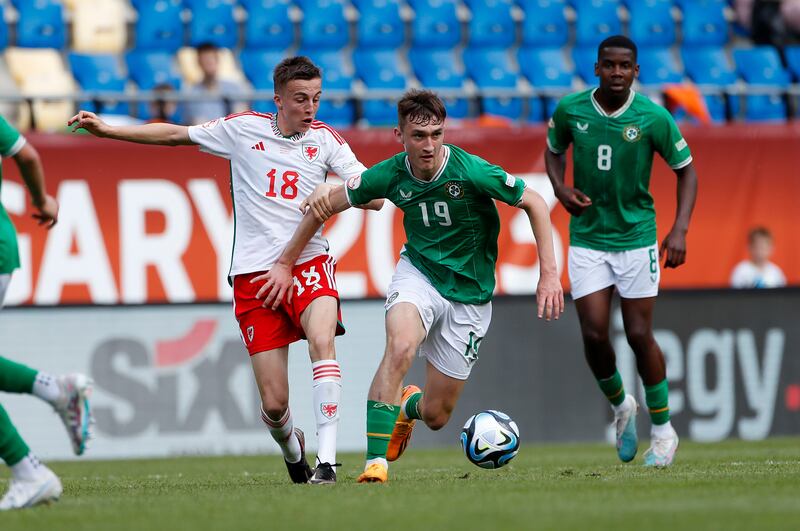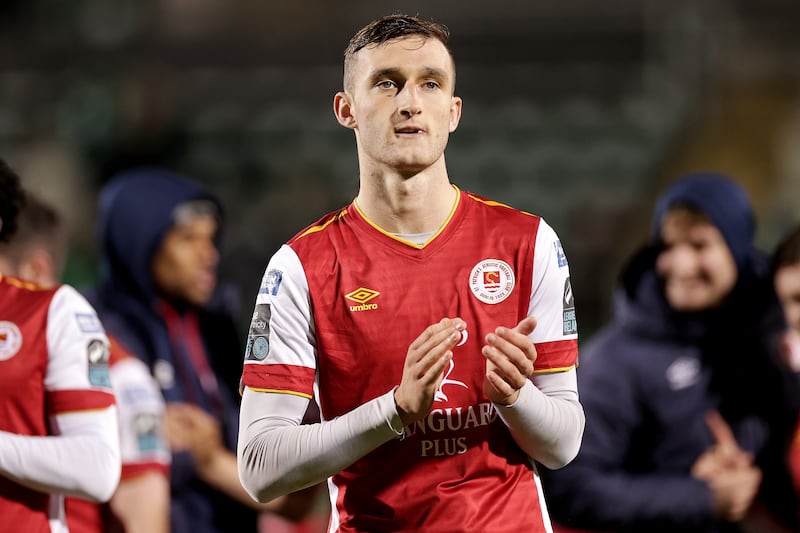At 8am on Wednesday, Mason Melia began his medical at Hotspur Way, the Spurs training ground in north London. The road that had brought the 17-year-old there from Newtownmountkennedy in Wicklow had been longer than anyone involved could have predicted but there was a bit to go yet.
Spurs first got in touch with Melia and his family in 2021, when he was still with Bray Wanderers. This was long before he became the youngest ever goalscorer in the League of Ireland, before his two hat-tricks for the Ireland under-17s in 2023, before he was named the PFAI’s Young Player of the Year in 2024. Now that they had him inside the building, a few more hours weren’t going to make much difference.
Melia’s medical was complicated slightly by the one bit of family history everyone in football already knew. All the way up along, his guiding light in the game has been his uncle Clive Clarke, the former Stoke, Leicester and Ireland defender. In August 2007, Clarke had a cardiac arrest at half-time in a game between Leicester and Nottingham Forest. Four weeks later, Clarke’s sister Pamela gave birth to her second child.
Now, in February 2025, that child was undergoing a medical at one of the biggest football clubs in the world. Clarke is a partner in the agency that represents his nephew, so he was in the building as well. And because it’s common knowledge that Melia’s footballer uncle had his career ended by a mystery heart problem, the cardio part of the medical was especially stringent and took a bit longer than usual.
RM Block
In the end, everything was as it needed to be. At 6.30pm, after a day of endless coffees downed by his waiting family, Melia emerged with a five-year contract, to begin next January. As they stood around and drank it all in, Clarke’s business partner and licensed agent, Dan Fletcher, cracked that it had only taken them four years to get the deal done.
So what now? For all the hoopla this week, nothing about Melia’s football career is inevitable from here. He has the coming season with St Pat’s to attend to. He will turn 18 in September. The transfer fee – an initial €1.9m with add-ons that could in time bring it up to €4m – has put a pep in the League of Ireland’s step on the eve of the new season. But for the player himself, everything has changed and nothing has changed.

When he joins Spurs next January, Melia will be surrounded by some of the best young players in Europe and nobody will give a single rooty-toot for what he did in Ireland. So far this season, Spurs have given first-team playing time to three teenagers and only this week beat Manchester United to the signature of 19-year-old Bayern Munich winger Mathys Tel on loan. Melia will have plenty of bodies to clamber over before he sees Premier League daylight.
The broader picture is more interesting for now. For the League of Ireland, the first ever transfer fee over €1m has been a long time coming. The previous record of €600,000, paid by Celtic to Shamrock Rovers for Liam Scales in 2021, was always a pitiful amount and a damning indictment of the status of the domestic game.
As long as bigger clubs from richer leagues feel they can plunder here with impunity, they will. One of the more demoralising episodes in recent years came in 2020, when Cork City had to do a quick deal with Preston North End to cancel the add-ons for the transfers of Sean Maguire and Alan Browne, all in return for a paltry €500,000.
Cork had an outstanding debt to the Revenue to sort out at the time and had to take what they could get. Maguire cost Preston just €150,000 and went over as the reigning top scorer in the League of Ireland, eventually playing 170 games. Browne became club captain and ended up playing 414 games for Preston, having cost next to nothing out of the Cork academy. The add-ons were the thing. But Cork City had to give them up for a measly half a million quid.
Does the Melia transfer change that whole scene? Though plenty in the league dearly hope so, they are still inclined to believe it when they see it. The idea that this is a line in the sand, a warning to other leagues that the days of pillage are over – let’s just say people are sceptical.
For one thing, there aren’t dozens of Mason Melias out there. There’s a reason he was such hot property, coveted by so many clubs across Europe over the past two seasons. Though he only scored six goals in the league last season, he has shown an ability beyond his years to live and prosper in the world of men’s football.
The Melia move may well have changed everyone’s idea of what full value is. Only time will tell on that score.
When Tottenham first started talking properly about signing him, their initial offer was still only in the region of €400,000. But as he kept hitting markers that players his age had never hit before – man of the match in a Conference League qualifier against Istanbul Basaksehir at 16, called up to the Ireland under-21s at 17 – the potential fee kept growing.
Secondly – and crucially – there aren’t many Garrett Kellehers out there. The St Pat’s owner is an uber-wealthy property developer who has been able to bring in American investors to support the club, including NFL star Joe Flacco. Pat’s had the money and the security to sign Melia to a three-year contract in November 2023, immediately setting a worth that anyone coming calling for him would have to honour.
Kelleher was happy – eager, even – to wait it out until the right offer came along, rather than hurry Melia out the door to a European suitor for a quick fee. Not everyone has that luxury. For all that the league is thriving and excitement around the new season is building, most clubs still live a comparatively hand-to-mouth existence compared with other countries. The temptation to cash in on a Melia wouldn’t always be resisted.
That said, the Irish market has definitely had a sheen applied to it over the past few seasons. The Brexit ruling that has kept young players here until they turn 18 rather than hooshing them over to England at 16 has helped the rising tide. Someone such as Sam Curtis, Melia’s predecessor as PFAI Young Player of the Year, would have been long gone over to England in a different era. Instead, he played 60 senior games for St Pat’s before his 18th birthday.
“The Brexit thing works two ways,” says Fletcher, who has been an agent for more than 20 years and has done transfer deals across Europe, the US and Australia. “I think it has made the league stronger in Ireland, definitely. Mason is a prime example of that. Players are so focused on coming to England that they’re prepared to wait, rather than go to Italy or Belgium or the Netherlands.
“The other effect is that it has changed to some extent how the industry sees Ireland. Clive and I had a long conversation about this when Brexit happened. We started going quite strong on Ireland. A lot of clubs are going back to Ireland, a bit like they did in the 80s and 90s.
“Most clubs have got Irish scouts now, which they didn’t have previously. It was always a case of you speaking to someone here in England and they would send someone over to Ireland to watch the player. Clubs would have had someone who would cover Ireland but not necessarily be based in Ireland. Whereas now, most Premier League and Championship clubs have dedicated scouts who live there.”

For all that, you wouldn’t say there has been a flood of talent flowing out of the league this off-season. Neil Farrugia’s displays during Shamrock Rovers’ European run saw him move to Barnsley at the end of his contract and Johnny Kenny was recalled to Celtic – but both of those were expected. Bohemians lost under-19 international Nickson Okosun to Watford for an undisclosed fee.
But otherwise, the majority of the closed-season movement has been between Irish clubs. Arguably the biggest transfer story before the Melia news was the move of highly-fancied 16-year-old Michael Noonan from St Pat’s to Rovers. Noonan turns 18 in the summer of 2026 and Rovers have given him a two-year contract. With a string of clubs including Manchester City already having expressed an interest, Rovers will be keen to extract full value when the time comes.
The Melia move may well have changed everyone’s idea of what full value is. Only time will tell on that score. For now, Melia is back in Dublin after a week that ended a process that would have turned any kid’s head. The past few years of his life have been a whirlwind of flights and calls and meetings, all over the continent.
City Football Group offered him a contract 18 months ago that involved an initial move to a feeder club in Belgium. They came armed with a long-term deal and a signed jersey from Erling Haaland but Melia, who was still only 15 at the time, didn’t bite. Chelsea, Bayer Leverkusen and Everton all tried to sign him – with Everton coming closest, putting in a firm bid of just under €1m.
Eintracht Frankfurt told him they wanted him to come to Germany because they were about to lose a striker to a bigger club. The striker they were talking about was Omar Marmoush, who City have just signed for €70m. These were the conversations Melia and his representatives were having and the decisions that were on the table for him.
In the end, Spurs won. The deal works for Pat’s, it works for Spurs, it works for Melia. There’s a pathway to first-team football for him. It’s not a simple one, and a million things can go right and wrong between here and then. But the pathway is there.
Up to him now to show he can walk it.
- Sign up for push alerts and have the best news, analysis and comment delivered directly to your phone
- Join The Irish Times on WhatsApp and stay up to date
- Listen to the Counter Ruck podcast for the best rugby chat and analysis





















